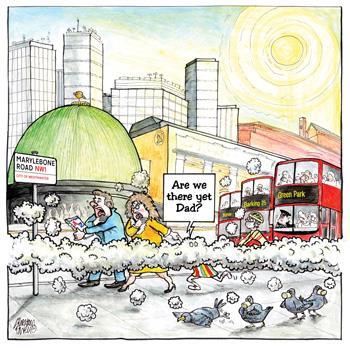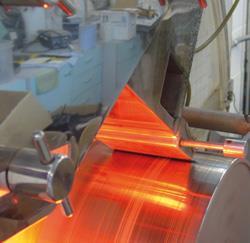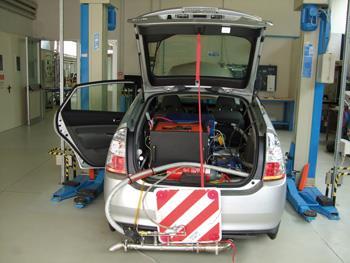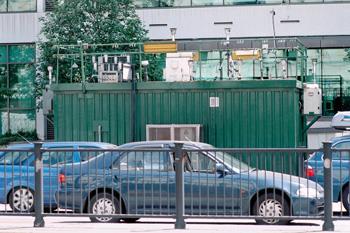Particulates from vehicles cause significant issues in urban environments. Emma Davies uncovers the chemistry that is causing and potentially solving the problems
Particulates from vehicles cause significant issues in urban environments. Emma Davies uncovers the chemistry that is causing and potentially solving the problems
The hordes of tourists that emerge blinking into the daylight from London’s waxworks museum, Madame Tussauds, pay little attention to the little green cabin on the other side of the road, separated as they are by six lanes of Marylebone Road traffic. The green cabin is an air monitoring ’supersite’, packed with technology to measure levels of every air pollutant, from polycyclic aromatic hydrocarbons to particles. To air pollution experts, Marylebone Road is an ’urban canyon’ that cuts through closely packed tall buildings. With over 80 000 vehicles travelling along it every day, the road is one of the most polluted in the UK - and a rich source of data.

’Air pollution is a bigger public health challenge than alcoholism or obesity at the moment. The problem is very, very serious,’ says Frank Kelly, who leads the environmental research group at King’s College London, which is responsible for air quality monitoring in the capital.
Of all the pollutants, ground-level (tropospheric) ozone, nitrogen dioxide (NO2) and fine particulate matter are most harmful to health, and the UK is struggling to keep levels of these pollutants in London below EU limits, facing significant fines.
Fine particles (with a diameter under 2.5m m; PM2.5) in particular are thought to be responsible for a host of respiratory and cardiovascular problems, including heart attacks and strokes. ’There are now half a dozen studies showing that fine particles can shorten your life expectancy,’ says Roy Harrison from the University of Birmingham, UK’s division of environmental health and risk management. Included in these is the frequently cited Harvard Six Cities Study, which evaluated the effects of particle exposure on adults in the 1970s and 1980s. The study found a strong, positive correlation between levels of air pollution and mortality. Whereas scientists originally focused on how pollution causes lung disease, in the past decade the focus has shifted to cardiovascular problems.
Invisible magic bullets
’In the London smogs of the 1950s, the concentrations of particles were in the hundreds of micrograms per cubic metre, so we could see the stuff and it wasn’t difficult to understand why it was having an effect on our lungs,’ says Kelly. ’Now the concentrations of these pollutants in the urban environment are miniscule in comparison (40-50 m g/m3) so the challenge to toxicologists is to understand how these small concentrations of particles and pollutants can lead to such dramatic health effects.’
The particles tend to have a simple carbon core but are coated with an array of chemicals. ’Very, very small particles act like magic bullets, carrying chemicals such as polycyclic aromatic hydrocarbons and transition metals to sites of our lungs, which previously hadn’t had to deal with this sort of challenge,’ Kelly adds.
In the late 1990s, Kelly and other researchers suggested that transport pollutants wreak havoc in the body because of their powerful oxidant nature. The fluid lining the respiratory tract and lungs contains a wide range of low molecular weight antioxidants, some of which come from the diet while others, such as uric acid and glutathione, are made in the body. All of which makes for some ’very interesting chemistry’ when oxidants are added to the mix, says Kelly. The thinking is that the particles trigger release of a cascade of clotting factors, which increase the risk of heart attacks and strokes.
Kelly’s group collects particulates from sites across London to look at the chemistry between particles from different environments and their interaction with a synthetic lung lining fluid. The researchers can estimate the oxidant nature of the particles by measuring the loss of protective antioxidants - ascorbic acid, glutathione and uric acid - from the fluid. ’London produces very, very oxidant particles,’ he says. ’If you go to a background site you lose some of the oxidant potential.’
Kelly blames many of London’s pollution problems on the dramatic rise in the number of diesel vehicles, which produce greater numbers of very fine particles. ’It is a known fact that diesel vehicles produce a lot more particulate pollution than petrol vehicles,’ says Kelly. ’They may be better for fuel efficiency and climate change, but they have been pretty disastrous for the air quality in our major cities.’
Harrison’s team has found clear evidence that vehicles produce two types of nanoparticles: those of graphitic carbon, which tend to be about 50nm in diameter, and smaller particles composed largely of semi-volatile hydrocarbon material, such as alkanes. The semi-volatiles form as hot exhaust gases, then mix and cool in the atmosphere. ’What is interesting is that those particles are tending not to be found in such great abundance now, and the reason for that seems to be that the sulfur content of the fuel is critical to their formation,’ says Harrison. Oxidation of sulfur dioxide can form sulfuric acid, which will condense on a suitable surface or form tiny new particles. The advent of ultra-low sulfur fuel has greatly reduced the formation of semi-volatile nanoparticles, he says.
Catalytic dust
Harrison is looking at ways to distinguish between different types of non-exhaust particles from vehicles, such as brake dust and those from tyre wear. ’One of the things we have found is that barium used in brake pads is a very good indicator of brake dust concentration,’ he says. The dust that comes from the road surface tends to have a large soil component, and can be recognised through elements like silicon, aluminium and calcium.

Meanwhile, researchers from the University of Birmingham’s chemical engineering and biosciences departments are seeing the value of road dust rich in platinum group metals from catalytic converters. A spin-out from the university called Roads to Riches is working on extracting the metals from the dust.
Angela Murray and her former PhD supervisor Lynne Macaskie are both directors of the company. Murray uses a combination of the metals’ physical properties - such as charge, density and magnetic susceptibility - to separate them, and is able to take road dust containing less than 1ppm precious metal and concentrate it up to around 10ppm. ’For the next stage we are looking at getting from 10ppm to somewhere between 60 and 100ppm,’ says Murray. ’The jump between 1 and 10ppm is far harder to achieve than the jump between 10 and 60ppm. The fact that we can concentrate up from that level is what we are excited about.’
Murray hopes to go to larger scale trials soon but is first focusing on finding an accurate, rapid and reproducible way of measuring concentrations of the precious metals in samples. ’The platinum group metals can interfere with each other, so it does make for complex analysis,’ she says.
In a separate project, Murray and Macaskie have teamed up with Birmingham microbiologist Kevin Deplanche to use bacteria to recover the metals from waste - after they have been solubilised into a liquid form - with the aim of producing new, cheap catalysts.
When Macaskie’s car was ready for scrap after 130 000 miles, the researchers removed the spent catalytic converter and applied Murray’s proprietary microwave leaching technique to create a metal ’soup’, which was treated with bacteria to extract the metals.
’We can recover all of the precious metals from the leachate,’ says Deplanche. ’We can turn waste into catalysts.’ The key problem is dealing with the leaching procedure itself. The leachate can be too acidic for the bacteria and high concentrations of silica and alumina can slow the extraction process.
The composition of catalytic converters varies widely, often reflecting the cost of particular platinum group metals. For example, new catalysts for petrol cars now rarely contain platinum. Because of this difference in source material, the researchers are exploring the idea of using waste to create catalysts. These would not be quite so selective as their purer counterparts, but a lot cheaper for ’dirty’ or high volume applications. ?
Different standards
London simply wants rid of its road dust. Worried that the city will breach EU legal limits for levels of particles with a diameter of 10 m m or less (PM10), local government body Transport for London (TfL) recently carried out trials of a dust suppressant (calcium magnesium acetate) in the hope that it would stick the particles to the road and reduce concentrations in the air. TfL reported some success at the two test sites known for their high levels of particulate matter, Victoria Embankment and Marylebone Road, claiming that ’repeated applications of dust suppressants are effective at reducing particulates by around 10 per cent over 24 hour periods’. TfL acknowledged that Marylebone’s ’canyon environment’ may provide more particulates for recirculation than an open environment and that percentage improvements may not be as good at other sites. The idea is to carry out more London tests.
The test scheme has its critics, including Kelly. ’I’m not a great believer in dust suppressants, mainly because of all the work that has been done on them in Europe. Two very good studies in Germany have shown that they don’t work,’ he points out. However, every cloud has a silver lining - if the calcium magnesium acetate dust suppressant can be made to work, then the new road waste will find a ready home. Macaskie and her colleague Mark Redwood have shown that one of their microbes, which extracts metals from waste, can also convert acetate into hydrogen that could be used as fuel.

European standards for vehicles were introduced over a decade ago to address air pollution. In London, Kelly’s team has seen little or no evidence of improvements in levels of the key pollutants. ’It took a few years for governments to believe it, but they have now acknowledged that the Euro standards are not working,’ he says. One of the key problems, explains Kelly, is the way that vehicle emissions are measured using factory rolling test beds. ’A vehicle on the road doesn’t perform the same way as it does in the factory.’
Researchers at the European Commission’s Joint Research Centre (JRC) have been investigating the difference in road emissions compared with factory emissions. They use a portable emission measuring system, which they take out in cars from the JRC base in Ispra, Italy. In tests, the research team found average NOx (NO and NO2) emissions of diesel vehicles to ’substantially exceed’ European emission limits, while petrol cars fared far better. ’The increasing stringency of European emission limits has not resulted in an equivalent reduction of on-road NOx emissions of light-duty diesel vehicles,’ states their technical report.
NOx iuos fumes

Nitrogen dioxide can cause respiratory problems, and at concentrations exceeding 200 m g/m3 becomes a ’toxic gas with significant health effects’ according to the World Health Organization. In the presence of hydrocarbons and ultraviolet light, NO2 is the main source of tropospheric ozone and of nitrate aerosols, which form an important fraction of PM2.5 mass.
The European Commission has set up a working group to look into developing a supplementary on-road emissions test procedure, following JRC recommendations.
Using a selective catalytic reduction (SCR) system can significantly cut NOx emissions from a diesel car. The setup needs a tank containing a reductant - usually urea - which is injected into the hot exhaust stream. The urea breaks down into ammonia and combines with NOx over the catalyst to give nitrogen, CO2 and water. Some car manufacturers already use this technology in some of their models.
Almost a third of global NOx emissions come from shipping. SCR catalysts are currently only installed in around 500 vessels, but uptake is predicted to increase when new shipping regulations come into force. Under the International Maritime Organization’s (IMO) regulations, ships built after January 2016 and operating in designated ’emission control areas’ will have to reduce NOx emissions by 80 per cent. SCR is currently the only proven technology capable of meeting the regulatory requirements, says Joseph McCarney, business development manager at catalyst specialists Johnson Matthey.
There are also other opportunities for reducing emissions of carbon monoxide, unburned fuel and carbon particulates from shipping. The problem is that shipping fuel currently has high sulfur levels, which would poison standard platinum group metal catalysts. The IMO is looking at restricting sulfur levels in marine fuel, which currently contains an average of 27 000ppm sulfur, compared with 10ppm for road fuel.
Making the invisible visible
There are large knowledge gaps when it comes to transport pollutants. ’We still don’t understand the chemistry of the particles terribly well,’ says Peter Brimblecombe, an atmospheric chemist at the University of East Anglia, UK. Then there is the complicating impact of weather systems. Harrison and Kelly are both involved in the Clean Air for London (ClearfLo) project, which combines data from pollution monitoring sites with meteorological measurements to investigate pollution in the lower atmosphere. One of the goals is to determine the chemical processes that control the loading of O3 and NO2 in London, in particular the role of emissions from vegetation.

Even before we have a complete understanding of the science, it is clear that reducing traffic on city roads can only be a good thing. ’People are simply not aware how much air pollution has changed,’ says Brimblecombe. ’How do you make the particles visible to people?’ is a question that he asks his students. ’There is a real need for a massive education programme,’ says Kelly. ’We are all part of the problem and we will all be part of the solution.’
Emma Davies is a science writer based in Bishop’s Stortford, UK
Further Reading
A M Jones and R M Harrison, Atmos. Environ., 2011, 45, 873 (DOI: 10.1016/j.atmosenv.2010.11.020)
R M Harrison, D C S Beddows and M Dall’Osto, Environ. Sci. Technol., 2011, 45, 5522 (DOI: 10.1021/es2006622






No comments yet